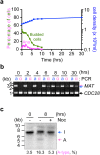Regulation of mating type switching by the mating type genes and RME1 in Ogataea polymorpha
- PMID: 29176579
- PMCID: PMC5701183
- DOI: 10.1038/s41598-017-16284-7
Regulation of mating type switching by the mating type genes and RME1 in Ogataea polymorpha
Abstract
Saccharomyces cerevisiae and its closely related yeasts undergo mating type switching by replacing DNA sequences at the active mating type locus (MAT) with one of two silent mating type cassettes. Recently, a novel mode of mating type switching was reported in methylotrophic yeast, including Ogataea polymorpha, which utilizes chromosomal recombination between inverted-repeat sequences flanking two MAT loci. The inversion is highly regulated and occurs only when two requirements are met: haploidy and nutritional starvation. However, links between this information and the mechanism associated with mating type switching are not understood. Here we investigated the roles of transcription factors involved in yeast sexual development, such as mating type genes and the conserved zinc finger protein Rme1. We found that co-presence of mating type a1 and α2 genes was sufficient to prevent mating type switching, suggesting that ploidy information resides solely in the mating type locus. Additionally, RME1 deletion resulted in a reduced rate of switching, and ectopic expression of O. polymorpha RME1 overrode the requirement for starvation to induce MAT inversion. These results suggested that mating type switching in O. polymorpha is likely regulated by two distinct transcriptional programs that are linked to the ploidy and transmission of the starvation signal.
Conflict of interest statement
The authors declare that they have no competing interests.
Figures








Similar articles
-
Mating-type switching and mating-type gene array expression in the methylotrophic yeast Ogataea thermomethanolica TBRC656.Microbiol Res. 2020 Feb;232:126372. doi: 10.1016/j.micres.2019.126372. Epub 2019 Nov 9. Microbiol Res. 2020. PMID: 31759230
-
Carbon source requirements for mating and mating-type switching in the methylotrophic yeasts Ogataea (Hansenula) polymorpha and Komagataella phaffii (Pichia pastoris).Yeast. 2020 Feb;37(2):237-245. doi: 10.1002/yea.3446. Epub 2020 Jan 6. Yeast. 2020. PMID: 31756769
-
Flip/flop mating-type switching in the methylotrophic yeast Ogataea polymorpha is regulated by an Efg1-Rme1-Ste12 pathway.PLoS Genet. 2017 Nov 27;13(11):e1007092. doi: 10.1371/journal.pgen.1007092. eCollection 2017 Nov. PLoS Genet. 2017. PMID: 29176810 Free PMC article.
-
An Evolutionary Perspective on Yeast Mating-Type Switching.Genetics. 2017 May;206(1):9-32. doi: 10.1534/genetics.117.202036. Genetics. 2017. PMID: 28476860 Free PMC article. Review.
-
Mating-type gene switching in Saccharomyces cerevisiae.Trends Genet. 1992 Dec;8(12):446-52. doi: 10.1016/0168-9525(92)90329-3. Trends Genet. 1992. PMID: 1492369 Review.
Cited by
-
Genomic diversity, chromosomal rearrangements, and interspecies hybridization in the Ogataea polymorpha species complex.G3 (Bethesda). 2021 Aug 7;11(8):jkab211. doi: 10.1093/g3journal/jkab211. G3 (Bethesda). 2021. PMID: 34849824 Free PMC article.
-
On the evolution of variation in sexual reproduction through the prism of eukaryotic microbes.Proc Natl Acad Sci U S A. 2023 Mar 7;120(10):e2219120120. doi: 10.1073/pnas.2219120120. Epub 2023 Mar 3. Proc Natl Acad Sci U S A. 2023. PMID: 36867686 Free PMC article. Review.
-
What makes Komagataella phaffii non-conventional?FEMS Yeast Res. 2021 Dec 24;21(8):foab059. doi: 10.1093/femsyr/foab059. FEMS Yeast Res. 2021. PMID: 34849756 Free PMC article. Review.
References
Publication types
MeSH terms
LinkOut - more resources
Full Text Sources
Other Literature Sources
Molecular Biology Databases
Research Materials
Miscellaneous

